In 1892 the army abandoned Fort Shaw, located 24 miles west of Great Falls, Montana . The Indian Office (later known as the Bureau of Indian Affairs) took over the facility and began to convert it into the nation’s fourteenth boarding school. Fort Shaw had been established following the Civil War to protect American settlers from Blackfoot raids. The new school was intended to house 250 students. The initial survey of the structures at the fort showed that 15 of the fort’s 25 structures were judged to be in fair condition and the rest were in poor or very poor condition.
As with other off-reservation boarding schools run by the Indian Office, discipline was seen as the key to success at the new Fort Shaw Indian School. Discipline involved military style marching: on the parade ground the students would be divided into squadrons with the boys in one squadron and the girls in another. In this formation, they would be taught the rudiments of military marching. Fort Shaw was a former military base and the new Fort Shaw Indian School, like other Indian boarding schools at this time, was run as a military school. Instilling military discipline into the boys and girls, according to the prevailing pedagogical thought regarding Indian education at this time, would instill in them the habits they would need for life outside of the reservation.
With regard to academics, one of the primary concerns was making sure that the students spoke English and only English. Speaking an Indian language was prohibited and students caught speaking Indian languages were to be severely punished.
The school’s curriculum was based on the models established by the earlier Indian boarding schools, namely Carlisle and Chemawa. The boys were to be educated to become laborers or farmers, and the girls were educated to become domestic servants or housewives.
The Indian boarding school on the Fort Peck Reservation burned down, so the government felt that it would be best to ship the students far away from the reservation and the influence of their relatives. Fort Shaw was 350 miles away and thus it was too far away to allow for regular visits by family members. The school’s isolation also discouraged runaways.
Thirty-five boys and girls travelled from Fort Peck to Fort Shaw, arriving there before the school was actually scheduled to be opened. Coming with the students was the superintendent of the Fort Peck school and his wife, both of whom joined the staff at the new Fort Shaw Indian school.
In 1893, the first students from the Blackfeet Reservation (note: Blackfeet is the American name while the elders prefer Blackfoot) arrived at the Fort Shaw Indian School. Soon three of the oldest Blackfoot students plotted their escape. Within days after arriving at the school they made their bid for freedom. Their short exposure to the harsh discipline, confinement, and regimentation at the school made it intolerable. The three escapees found that they could make the 75 miles back to the reservation in a single day and make a makeshift camp where they spent a cold night with no fire. In the morning they voluntarily returned to the school.
Three recent graduates of the Carlisle Indian School were invited to join the staff at the Fort Shaw Indian School as Indian teaching assistants. It was felt that these male and female teaching assistants would serve as role models for the other students.
In 1895, Louis Goings, a Shoshone from Wyoming, arrived at the Fort Shaw Indian School to teach the cobbler’s trade. In addition, he began to build an athletic program modeled after the one at the Carlisle Indian School.
Another addition to the Fort Shaw teaching staff in 1895 was Josephine Langley (Blackfoot) who came from the Carlisle Indian School. At Carlisle, Langley had become acquainted with the new sport of basketball and she began to teach basketball to the girls at the Fort Shaw Indian School. Her request for a regulation basketball and a pair of baskets, however, was turned down by the school’s administration.
By 1897 the Fort Shaw Indian School was now the only school in Montana-for Indians or non-Indians, college or high school-which incorporated basketball into its physical culture curriculum.
In 1900, the Fort Shaw Indian School football teams played local teams in Great Falls and Butte. In Great Falls, Fort Shaw girls led the team out onto the field with bright banners and a series of school yells, In Butte, more than 1,500 fans watched the game.
The purpose of the Indian boarding schools, such as the Fort Shaw Indian School, was to strip from their students all vestiges of their Indian-ness. Thus, when the students arrived, they were stripped, their old clothes were often burned, and they were issued military-style uniforms. The boys would have their hair cut, as long hair was seen as incompatible with learning and American civilization. However, the general public was fascinated by Indians-Indians who looked like the stereotypes fostered by the Wild West Shows. Thus, in 1902 the Fort Shaw Indian School added a new component to their exhibit at the Cascade County Fair: they displayed authentic examples of Indian ceremonial attire and traditional crafts. The exhibit drew record crowds.
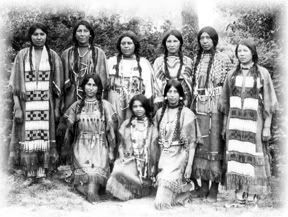
Shown above is the 1903 Fort Shaw Girls Basketball team in native dress.
Fort Shaw emphasized athletics and its teams competed with a variety of non-Indian teams. However, in 1904, the state teachers’ organization formalized an interscholastic athletic association to systematize athletics. Under the new rules only accredited colleges and high schools were allowed to join. This excluded the Fort Shaw Indian School from competition.
In 1904, the Fort Shaw Girls Basketball Team was invited to the Louisiana Purchase Exposition in St. Louis. As a part of this exposition, the Department of the Interior (of which the Indian Office is a part) built a Model Indian School to show that Indian children:
“can talk; that they can sing; that they can learn; that they are docile and obedient; that they are human.”
Students from Chilocco, Haskell, Genoa, and Sacaton Indian Schools lived at the school. About 30,000 visitors a day pased through the Model Indian School.
The Fort Shaw Indian School basketball team played against local land regional championship teams and was crowned the World’s Champion Girls Basketball Team. According to comments in the visitors’ book, the Fort Shaw Girls Basketball Team was one of the major reasons for the popularity of the Model Indian School.
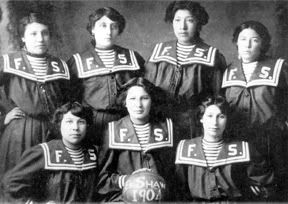
The 1904 Fort Shaw Girls Basketball Team is shown above.
In 1910, the Fort Shaw Indian School was closed because of declining enrollments and changes in federal policy regarding boarding schools.
For more about the 1904 Fort Shaw Girls Basketball Team, let me recommend:
PEAVY, LINDA, and URSULA SMITH
2008 Full-Court Quest: The Girls from For Shaw Indian School Basketball Champions of the World. Norman: University of Oklahoma Press.
PBS also produced a video called “Playing for the World” which provides some additional insights.
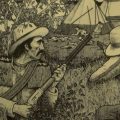
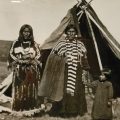
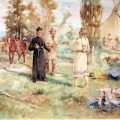

Leave a Reply